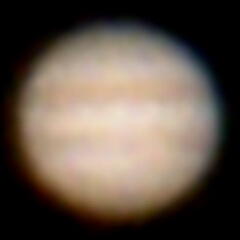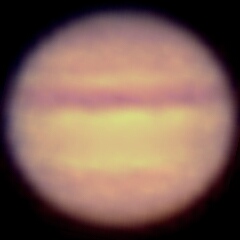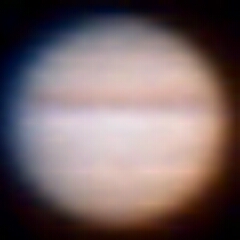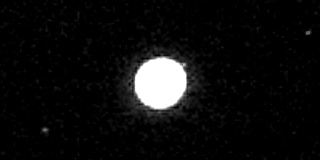Jupiter: Picture Gallery
Jupiter is the largest planet in the solar system so even though it doesn't come particularly close to the Earth it is still a good telescopic subject. The famous astronomer Galileo thought so too, as it was he who discovered Jupiter's four brightest moons Callisto, Europa, Ganymede and Io: they are now called "The Galileans" in his honour. The quartet are easy to see in even a small telescope so plotting their movements around the giant planet can be a good project - I did this with my refractor when a teenager and got excellent results for their orbital periods.
| |
 |  |  |
| These images, taken on different days in spring 2005, are expanded by a factor of three to show the cloud bands and features on the planet more clearly. The north and south equatorial bands are particularly striking and the darker areas at each pole are also well seen. The colours are fairly typical: mid-brown bands on a light brown to yellowish globe. Occasional dark "blobs" and wisps can also be made out: these are semi-permanent localised storm patterns in the band structure, of which the most famous is the Great Red Spot (see below). |
 |  |
| Visible in the bottom part of the lower cloud band (to the right on the first image, to the left on the second), the Great Red Spot is the most well-known feature on Jupiter. Known to have existed since at least 1664, it is not actually a solid object at all, just a huge vortex in the clouds covering the planet. Its reddish-brown colour is due to complex chemicals created in reactions stirred by the fierce winds that keep the vortex circulating. |
 |
It is noticeable that Jupiter is definitely "fatter than it is tall": this broadening is due to the effect of centrifugal force caused by its rapid rotation - just 9hrs 50min. Observing the planet at different times on one night will easily show the rotation, as discrete features travel from the left limb of the planet to the right. The movie shows a dark spot on the lower edge of the upper equatorial band moving across the disc in an hour (note that the timesteps are not equal). |
| And this one shows the rotation of the Great Red Spot - it is actually a composite of two night's observations to show the Spot moving almost completely from one side to the other. The odd angle of Jupiter in the movies is just a reflection of the way my telescope is set up: you can get the widest field of view if objects track across the diagonal. I usually rotate the images to some degree afterwards but didn't want to do this for the movie frames to avoid the inevitable small loss of detail when this is done. |  |

In 2004, Jupiter was at opposition (nearest to the Earth) on 3rd/4th March, represented by the view on the left [actually taken on the 1st]. By the time the view on the right was taken [27th May] the Earth had moved sufficiently further away that the image size had decreased significantly (by about 15%, in fact). This shows why it is important to observe planets near opposition to capture the maximum detail.
The 2010 opposition was special in three ways. Firstly, Jupiter was very close to Uranus which was also at opposition - I've put a picture of this on the "Conjunctions" page. Secondly, Jupiter was at perihelion and so was also unusually close to the Earth - the closest since 1963 and until 2022. Thirdly, it had lost the Southern Equatorial Belt. This is an unusual and unpredictable phenomenon thought to be caused by changes to the global wind-patterns that distribute the coloured and white components of Jupiter's atmosphere round the planet.
 |
The relative closeness of Jupiter on this occasion meant that its apparent diameter was considerably greater - 50 arc-seconds compared to 44 in 2005. Also, it was much higher in the sky and so could be seen through a smaller thickness of the Earth's atmosphere. Added together, these factors made the image brightness much higher, meaning I could take pictures showing more detail. This is illustrated by the image to the left, taken exactly at opposition on 21st September - click on it to see the names of the features. Note the missing South Equatorial Belt, the very clear thin line of the North Temperate Belt and the brown features in the North Equatorial Belt. These are called "barges" and are caused by similar processes to those which maintain the Great Red Spot (the GRS was not on display at this time). The colours in this image are, unfortunately, clearly not correct: this is due to a problem with the colour-balance of the original images that I only realised while processing them later. I have retained it however because the false colours actually show the belt structure rather better than "true" colours. |
| This image, taken about a month later, demonstrates how much easier it was to see the Great Red Spot in the absence of the South Equatorial Belt: compare it with the other GRS images above. The image also shows the South Temperate Belt very nicely, just below the GRS, and illustrates how much lighter in tone the planet looks without the SEB. |  |
 | The SEB started to re-appear in November, beginning with a series of small dark spots. These were breaks in the white cloud-tops, which gradually spread round the planet and slowly restored the belt. This image was taken in late January 2011 and shows the characteristic dark colour returning to the lower equatorial regions, especially to the right. |
Jupiter's moons
Of the 63 currently-known moons, only the Galileans are of any size - around 2600mls in diameter. Of the rest, there are a couple about 100mls in diameter, ten that just get into double figures, then a vast array of tiddlers! The very small ones are almost certainly captured asteroids, as they are so far from Jupiter (around 12 times as far away as the farthest Galilean) and mostly orbit "the wrong way round". The Galileans all orbit very close to Jupiter's equatorial plane so, as the planet's rotational axis has a tilt of only 3 degrees relative to the Earth's orbit, they are usually seen strung out more-or-less in a straight line on both sides of the planet. They often pass in front of or behind the planet as seen from Earth, resulting in fewer than four being visible at a given time: observing them disappearing and re-appearing can be most interesting. They can even block each other out on occasion!

Here we have the planet together with three of its largest moons - Europa, Ganymede & Io (left to right). Callisto was visible that night but was so far to the left I've had to crop it off to make everything fit! The picture is a slight cheat as it's not possible to pick an exposure that will satisfactorily capture both the bright planet and the dimmer moons - this view is actually a composite but gives an excellent impression of what you can see through a large telescope.

But just to prove that the 'The Galileans' are indeed a quartet and not a trio, here are Io, Europa, Callisto and Ganymede lined up on the same side of Jupiter. This is a single image, not a composite, and of course Jupiter itself is over-exposed in order to capture the moons. Click on any moon to get further details.
As mentioned above, Jupiter's moons can go behind or in front of the planet and thus disappear from view for a while. It is possible with larger telescopes to follow them as they cross the disc, but not with mine I'm afraid. However, see later for another possibility!
| |
 |  |
| Ganymede is caught right on the point of passing in front of Jupiter, just above the upper cloud band to the left of the planet. | And here it is just after having left the disc, to top right, but on another occasion. |
Given that moons can become not visible by passing in front of or behind Jupiter (called being "in transit" and "occulted" respectively), the question arises as to whether it is possible to have all four moons not visible at the same time. The answer is yes, indeed it is, but the phenomenon would be rather uncommon were it not for another way a moon can be not visible: if it enters Jupiter's shadow i.e. it is in eclipse. This can be quite a significant factor if Jupiter is far from the Sun in the sky, as then its shadow will extend for a considerable distance out to the left or right and so the chance of a moon being in eclipse will be much increased. Indeed, were it not for eclipses, there would only be eight "Jupiter Without Satellite" events (as they are called) from 1900 to 2100. With eclipses, the number rises to 45 - the most recent one visible from the UK was on 22nd May 2008, from 4:50 BST (when Io entered eclipse) to 5:08 BST (when Ganymede re-appeared from behind Jupiter). I had hoped to capture the event with my telescope plus webcam but, despite bright sunshine the day before, cloud had gathered by dawn so I didn't see a thing! The next one visible in the UK at night won't be until 2033.
Occasions where Only One Satellite is visible ("OOS" events) are rather more frequent, if not exactly common. The sole visible satellite is almost always Callisto, mainly because its much slower motion means it doesn't come close to Jupiter all that often.
For further fascinating (but rather technical!) facts about JWS and OOS events, click here.
It is also possible for the Galileans to occult, transit and eclipse each other, but only when the plane of their orbits is pointing directly towards the Earth (else they would pass above or below each other). This happens about once every 6yrs, the next occasion being in 2021. There are many types of event that happen during this period but unfortunately most of them will only be properly visible with large telescopes due to the small size of the moons' discs, and of course you can't see anything if Jupiter isn't against a dark sky at the time!
| Because Callisto orbits so far out even the slight tilt of Jupiter's rotational axis is just enough to often cause it to "miss" the disc of the planet, instead of crossing in front of or behind it, and so appear to be directly above or below Jupiter. Here we have Callisto performing a pass below the Jovian south pole on 28th May 2005. |
 |
 | The Galileans move round Jupiter quite quickly - so much so that their motion is easily visible after only a few minutes. This is shown by this movie where, in the space of just half an hour, Ganymede appears from in front of Jupiter and moves away to the right while Io proceeds even faster in the opposite direction. They are not actually going in different rotational directions of course - all the major moons rotate the same way round Jupiter (anti-clockwise when seen from above the north pole). In the movie, Ganymede is in the part of its orbit that takes it between the Earth and Jupiter and so it moves from left to right but Io is "behind" Jupiter and so moves the other way as viewed from the Earth. |
Shadow transits
As I mentioned earlier, although it is difficult to see a moon cross Jupiter's disc, there is another possibility which is potentially easier to spot. In the same way that our moon can go between the Earth and the Sun and thus cast a shadow on the Earth (producing a solar eclipse), the satellites of another planet can do the same thing. A solar eclipse caused by the moon Phobos has actually been observed from the surface of Mars by the Opportunity rover! The shadows caused by Jupiter's Galilean moons are quite large, as the moons themselves are very big and they orbit quite close to their parent. A (dark) shadow is also much easier to see against the disc of Jupiter than a (bright) moon. Factor in the absence of one of the dark belts and the possibility of capturing these "shadow transits", as they are called, suddenly gets a whole lot greater.
During the close opposition of September/October 2010 I found I could capture these transits relatively easily, so I produced quite a few images and animations of such events. Click here to see what I managed to get.
Digital camera pictures
| The Galileans are so large and bright that they would be just visible to the naked eye if Jupiter itself were not present. These pictures go some way to showing that, and also take us back to the time when Galileo discovered them. The shots were taken directly with an ordinary Minolta digital camera i.e. with it simply pointing at the sky with no telescope involved. True, it was on the 200mm setting with x4 digital zoom added, and then the images were cut out of a much bigger one, but essentially what you see is what the camera got. All four Galileans were visible at the time each of the shots was taken, but there appear to be only three visible in the second image. This is because the fourth one was sufficiently close to Jupiter to get "lost in the glare": this was exactly what happened to Galileo the first time he saw the moons. He thought there were only three initially because his telescope was not good enough to see any that were close to the planet. |
 |
 |
 |
 |




















